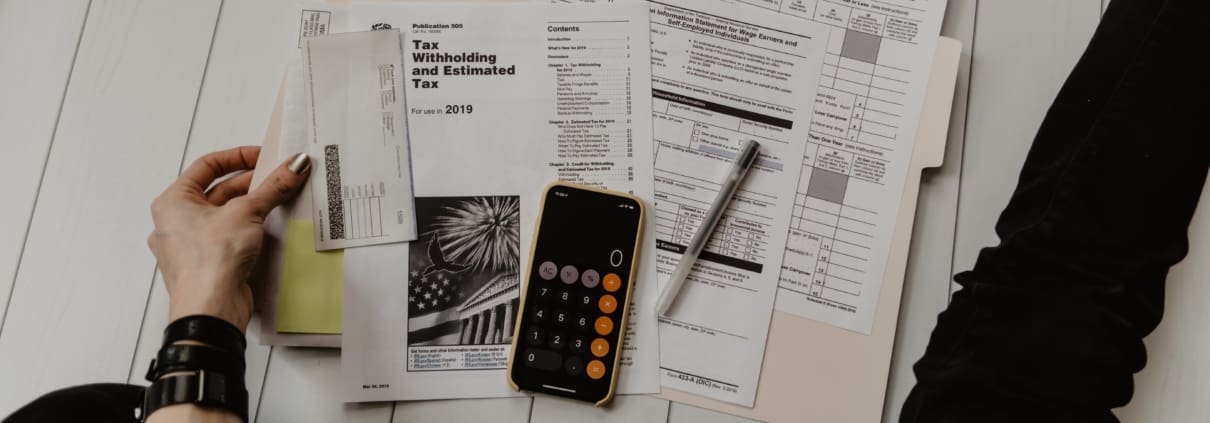How to Prepare Your Business for Tax Time

Planning ahead is always a good business strategy, especially when it comes to taxes. Adopting a proactive strategy can help you stay ahead of business tax filing deadlines, avoiding the rush and the headache during tax season!
To help business owners prepare their tax, we’ve prepared a business tax filing guide to walk you through the process.
Deadlines
Any good business tax filing guide should start with the various filing deadlines associated with taxes for businesses. For a detailed explanation of these dates, you can check out this helpful article from Karen Doyle.
Here, we’ll summarize the need-to-know facts about various filing deadlines.
Income Tax for Individuals, Sole Proprietors, and Single-Owner LLCs
Individual taxpayers, sole proprietors, and single-owner LLCs must make estimated tax payments on a quarterly basis and file an annual income tax return.
The filing deadline is April 15. Deadlines for state income tax can vary, so your state’s tax collection authority can be a helpful tax guide for local deadlines.
2024 Tax Filing Deadlines for Estimated Income Tax
Businesses and self-employed individuals must submit quarterly estimated tax payments according to the following schedule:
- First Quarter: April 15
- Second Quarter: June 17
- Third Quarter: September 16
- Fourth Quarter: January 15, 2025
Estimated payments can be calculated using Form 1120-W.
Income Tax Returns for Partnerships and S Corporations
S Corporations and partnerships must file a return by March 15, 2024.
These organizations must generate a Schedule K-1 earnings statement for each partner or organization. The following forms will be needed to generate a Schedule K-1:
- Partnerships: Form 1065
- S Corporations: 1120S
You may file for a six-month extension by submitting Form 7004. You will also need to submit a deposit equal to the amount of tax owed. The return will be due on September 16, including any interest and penalties.
Corporate Income Tax Returns
Companies must submit a corporate income tax return by April 15, 2024. Corporations can request a six-month extension by filing Form 7004, though they will also be required to submit a deposit for their estimated taxes.
If your business requests an extension, the new deadline will be October 15, 2024. This will also be the deadline for your first quarterly tax payment.
If you do decide to request an extension, you’ll need to be prepared to pay your annual income tax from 2023, your quarterly tax payments, and any penalties or interest no later than October 15, 2024.
Employment Tax Filings for Wages and Non-Employee Compensation
Employers must distribute physical copies of tax forms by January 31 to any individual who received cash payments that include:
- Wages
- Non-employee compensation
- Dividends
- Royalties
- Profit-sharing distributions
Electronic copies may be submitted instead, but only with the consent of the employee.
Electronic copies must also be submitted to the Social Security Administration by the same date. The following documents are subject to the January 31 deadline:
- Forms 1097, 1098 and 1099
- Forms 3921 and 3922
- Forms W-2 and W-2G
Small businesses must submit corresponding copies to the IRS by February 28. Keep in mind that you may also be required to submit the following forms:
- Form 1096, Annual Summary and Transmittal of U.S. Information Returns
- Form 8027, Employer’s Annual Information Return of Tip Income and Allocated Tips
You may be able to receive an extension for filing electronically, though this varies by year.
2024 Payroll Tax Deposit and Form 941 Due Dates
Small businesses must file Form 941, Employer’s Quarterly Federal Tax Return, according to the following schedule:
- April 30
- July 31
- October 31
- January 31
The following forms are due on the last business day of the first month after the end of each calendar year:
- Form 940, Employer’s Annual Federal Unemployment (FUTA) Return
- Form 943, Employer’s Annual Federal Tax Return for Agricultural Employees
- Form 944, Employer’s Annual Federal Tax Return
- Form 945, Annual Return of Withheld Federal Income Tax
In 2022, this deadline falls on Monday, January 31.
Federal Excise Tax Requirements for Small Businesses
Some industries are required to pay excise taxes. Retailers, manufacturers, travel services, and communication companies file Form 720, the Quarterly Federal Excise Tax Return, on the following dates:
- April 30
- July 31
- October 31
- January 31, 2025
Form 11-C, Occupational Tax and Registration Return for Wagering is used for businesses that accept bets. This form must be submitted before accepting any bets. Form 730 must be submitted monthly.
Form 2290 is used for businesses that rely on heavy highway vehicles. This form must be filed by the last day of the vehicle’s first month of use. After this, the excise tax period runs between July 1 and June 30.
Tips
What can you do to adopt a proactive strategy when it comes to your business tax filings? Our business tax filing guide offers three tips that can help you be prepared for next year’s tax season.
Make Sure Your Books Are Caught Up
Keeping your books up-to-date is one of the most important things you can do for your business. The further you get behind in your bookkeeping, the harder it will be to stay current with your financial and legal obligations — that can quickly make tax season a nightmare!
Many small business owners cut corners by handling their own books, only to later discover that they’re in over their heads. Sound familiar? Don’t worry; you’re not the first.
Outsourcing these needs to a professional bookkeeping service can help you get caught up while keeping your business running smoothly all year round.
Gather Important Documents
You’ll also want to establish an organizational system to gather and preserve your important financial documents. We’ve already mentioned some of these earlier on this business tax filing guide, but the most important documents include:
- W2s from employers
- 1099s from contractors or miscellaneous income
- Documents showing itemized expenses (medical, educational, child care, etc.)
- Statements regarding investments
- Statements regarding mortgage interest payments
- Receipts from charitable donations
- Receipts for deductible expenses
These documents will be essential for calculating the federal income taxes that you owe.
Plan Ahead
Our business tax filing guide is based on a key principle: it’s better to be proactive than reactive. Not only does that mean keeping deadlines on your company calendar, but it also means finding creative ways to handle your tax debts each year.
For instance, you might plan a series of charitable donations that can be deducted from your income each year. You might also plan some type of investment or savings account that can be used to pay your tax debts.
Consulting a tax preparation service can help you to take advantage of every available deduction, which can lower your total tax payments for a given year.
Xendoo, Offering Proactive Solutions for Your Business
At Xendoo, we understand the demanding nature of modern businesses. We also understand that since the services of a CPA cost roughly $400 an hour, it can be challenging to stay up-to-date on your books. That’s why we’re committed to providing top-quality accounting and bookkeeping services that won’t break your budget.
When you partner with Xendoo, you’ll be able to rely on industry-leading services that include tax preparation, bookkeeping, and more, thanks to our experienced team of professionals.
Want to learn more? Reach out today, and we can start you and your business on the path to success.









